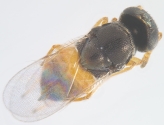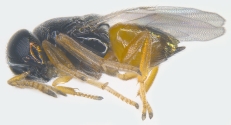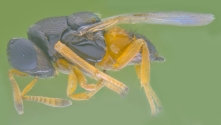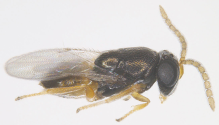 |
Scientific nameDiaphorencyrtus aligarhensis (Shafee et al.)
Taxonomic positionHymenoptera: Chalcidoidea: Encyrtidae: Encyrtinae
DiagnosisFemale: Head and mesosoma black, base of abdomen yellow-orange, rest of abdomen dark and shiny; antennae yellowish brown, outer margin of scape and pedicel infuscate, apex of antennal club darker brown; all pairs of legs yellowish. Antennal formula 1163. Metapleuron clothed with distinct white setae extending from base of hind coxa which is also clothed in moderately dense, conspicuous setae. Stigmal vein less than twice as long as marginal vein.
Male: Similar to female, except antennae light yellowish brown, covered with short whorls of setae and abdomen less broadly yellowish at base, posteriorly less dark than female. This is the only species of this genus known from India. ImagesDistributionIndia (Andhra Pradesh, Karnataka, Maharashtra, Punjab, Rajasthan, Uttar Pradesh). Also distributed in South Africa, Taiwan, China, Vietnam, Philippines, Reunion Island, UAR (Hayat, 2006). Introduced in the US (Florida).
Hosts / BiologyParasitic on nymphs of Psyllidae including Diaphorina sp., D. citri, D. cardiae on Cardia ruyxa, and Psylla sp. on Citrus sp. (Hayat, 2006). See Universal Chalcidoidea Database for complete list of hosts and associated plants.
References
|




